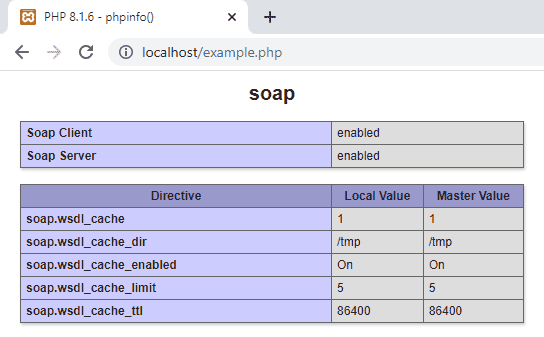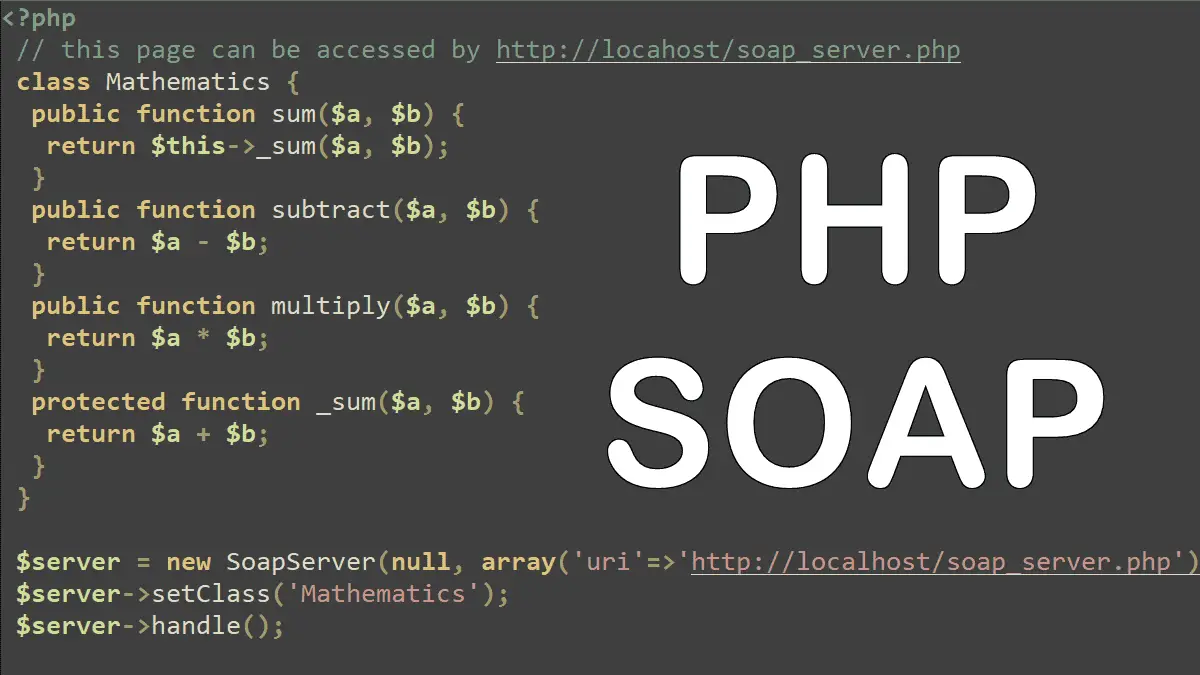Enabling SOAP Extension in PHP
The SOAP extension can be used to write SOAP Servers and Clients. Before moving forward, you should make sure that the SOAP extension is enabled. To verify, use the phpinfo() function and look for the SOAP section in the output:
<?php echo phpinfo();

If the SOAP section is not available in the output, you need to enable the SOAP extension by following these steps:
- Locate the
php.inifile in your PHP installation directory (for example, xampp/php/php.ini). You can use thephpinfo()function to find out where it is. - Open the
php.inifile with a code or text editor and search for the line contains;extension=soapdirective. Remove the semicolon (;) at the beginning of the line to uncomment it. - Save the
php.inifile and restart your web server to apply the changes. - To verify that the soap extension is enabled, you can use the
phpinfo()function again and look for the soap section in the output.
Creating a SOAP Server
The PHP soap extension provides SoapServer class to set up a SOAP web service with or without a WSDL (Web Service Description Language) description file.
To provide a SOAP Web Service, instantiate a class. The preceding code creates a Mathematics class for a simple Add, Subtract, and Multiply (we used the same class in the previous tutorial (Yet Another RPC Framework).
Example: Creating SOAP Web Service (nonWSDL Mode)
<?php
// this page can be accessed by http://locahost/soap_server.php
class Mathematics {
public function sum($a, $b) {
return $this->_sum($a, $b);
}
public function subtract($a, $b) {
return $a - $b;
}
public function multiply($a, $b) {
return $a * $b;
}
protected function _sum($a, $b) {
return $a + $b;
}
}
// Create SOAP server object
$server = new SoapServer(null, array('uri'=>'http://localhost/soap_server.php'));
// Register the Class with the server
$server->setClass('Mathematics');
// Handle the requests from the clients
$server->handle();
- Create a PHP class that defines the methods and parameters of your web service. (we created the
Mathematicsclass). - $server = new SoapServer(null, $options);
Next, create the SoapServer instance. In a nonWSDL mode, specify the following parameters:- Instantiate the
SoapServerinstance by passing itnullfor the$wsdl(first) parameter - And, specify a
urioption (assign current script URL) under the$options(second) parameter.
- Instantiate the
- $server->setClass(‘Mathematics’);
To handle incoming SOAP requests, use the setClass() instance method to set the class - $server->handle();
Use thehandle()method of theSoapServerclass to handle the incoming SOAP requests.
Creating SOAP Client
Now we have a SOAP server, let’s create a SOAP client. Creating a SOAP client in PHP is a relatively simple task, PHP soap extension provides SoapClient class to set up a SOAP client.
<?php /* this page can be accessed by http://locahost/soap_client.php */ $options = array( 'location' => 'http://localhost/soap_server.php', 'uri' => 'http://localhost/soap_server.php', ); $client = new SoapClient(NULL, $options); // Mathematics::sum echo $client->sum(49,51) . '<br>'; // 100 // Mathematics::subtract echo $client->subtract(51,49) . '<br>'; //2 // Mathematics::multiply echo $client->multiply(100, 10); // 100
The $client = new SoapClient(null, $options); creates the client instance. In a nonWSDL mode, specify the following parameters:
- Instantiate the
SoapClientinstance by passing itnullfor the$wsdl(first) parameter. - Specify the SOAP server address in
uriandLocationoptions under the$options(second) parameter.
Executing the client code consumes the SOAP Mathematics class service.
Creating a SOAP Service Using WSDL
Creating Server
In a nonWSDL mode, you pass null for the $wsdl (first) parameter and only pass a ‘uri’ option under the $options (second) parameter, but in a WSDL mode, you just need to pass the WSDL file address.
See How to create WSDL file automatically.
Example: Creating WSDL Soap Server
<?php
// this page can be accessed by http://locahost/soap_server.php
require_once 'Mathematics.php'; // PHP Class
$server = new SoapServer('Mathematics.wsdl');
$server->setClass('Mathematics');
$server->handle();
Creating Client
In WSDL mode, just pass the WSDL address to SoapClient class.
Example: Creating WSDL Soap Client
<?php
/* this page can be accessed by http://locahost/soap_client.php */
$client = new SoapClient('http://localhost/Mathematics.wsdl');
// Mathematics::sum
echo $client->sum(49,51) . '<br>'; // 100
// Mathematics::subtract
echo $client->subtract(51,49) . '<br>'; //2
// Mathematics::multiply
echo $client->multiply(100, 10); // 1000
Communicating with Servers:
